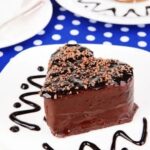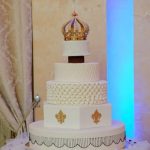Fondant decorations have become a popular choice for adorning cakes, adding an element of elegance and sophistication to any dessert masterpiece. These edible works of art are versatile in design and can create a professional finish that is sure to impress. In this article, we will explore the world of fondant decorations and provide you with step-by-step instructions on how to apply them to your cake.
Fondant decorations are made from a pliable icing that can be rolled, molded, and shaped into intricate designs. They are often used for creating smooth finishes, delicate flowers, elegant borders, and personalized messages on cakes. The beauty of fondant lies in its ability to transform an ordinary cake into a visually stunning creation.
One of the reasons why fondant decorations have gained popularity among bakers and cake decorators is their versatility. Fondant can be colored, flavored, and easily transformed into various shapes and designs. Whether you’re aiming for a minimalist modern look or a whimsical theme, fondant allows you to bring your creative vision to life.
By following the steps outlined in this article, you’ll learn how to select the right fondant for your project, prepare your cake for fondant decorations, roll out the fondant smoothly, create stunning designs using different techniques, troubleshoot common issues that arise when working with fondant, add finishing touches for maximum visual impact, and ultimately turn your cake into a work of art.
Now let’s embark on this journey together as we delve into the beautiful world of fondant decorations and discover the joy of creating unique masterpieces that showcase both skill and creativity.
Selecting the Right Fondant for Your Cake
Fondant is a popular choice for cake decorating due to its versatility and professional finish. When it comes to selecting the right fondant for your cake, there are a few factors to consider such as the type of fondant available in the market and the specific requirements of your cake project.
There are different types of fondant available, including rolled fondant, poured fondant, and marshmallow fondant. Rolled fondant is the most commonly used and can be easily rolled out and draped over a cake. Poured fondant is a creamy consistency that is ideal for covering small cakes or creating glazes. Marshmallow fondant is made from melted marshmallows and has a sweet taste, making it a popular choice for both taste and texture.
When choosing the best fondant for your specific cake project, it’s important to consider factors such as weather conditions, desired texture, and taste. If you’re working in a humid environment, it’s recommended to use a firmer type of fondant that will hold its shape better. For cakes that require intricate details or sculpting, a softer and more pliable fondant may be preferred. It’s also important to choose a fondant that complements the flavor of your cake.
To summarize:
- Rolled Fondant: Versatile and easy to work with
- Poured Fondant: Creamy consistency for glazing cakes
- Marshmallow Fondant: Sweet taste and pliable texture
- Consider weather conditions (firmness vs. softness).
- Desired texture (firm vs. pliable).
- Flavor compatibility with your cake.
By carefully considering these factors, you can select the right fondant that will not only decorate your cake beautifully but also enhance its taste profile. The next step after selecting the right fondant is preparing your cake for the application of decorations, which will be discussed in the next section.
Preparing Your Cake for Fondant Decorations
Why Preparing Your Cake for Fondant Decorations is Important
Before applying fondant decorations to a cake, it is crucial to properly prepare the cake itself. This step is essential for achieving a smooth and flawless finish with the fondant. A well-leveled and crumb coated cake provides a stable base for the fondant to adhere to and ensures that any imperfections or bumps in the cake are minimized.
Step-by-Step Instructions for Preparing Your Cake for Fondant
- Leveling: Start by leveling your cake layers. Uneven or domed layers can cause the fondant to crack or sag later on. Use a sharp serrated knife or a cake leveler to trim any excess from the top of each layer until they are level.
- Filling: Once your cake layers are leveled, it’s time to fill them with your desired filling. Make sure to use an even layer of filling between each layer, spreading it out with a spatula or piping bag.
- Crumb Coat: A crumb coat is a thin layer of icing that seals in any crumbs and creates a smooth surface for the fondant. Apply a thin layer of buttercream or ganache all over the cake using an offset spatula, ensuring that you cover all sides and edges.
- Chill: Place your crumb-coated cake in the refrigerator for about 30 minutes to allow the icing to set. This will make it easier to apply the fondant later on.
- Final Icing: After chilling, remove the cake from the refrigerator and apply another layer of icing over the crumb coat. Smooth out any visible imperfections with your spatula, ensuring that you have an even and clean surface.
By following these steps, you will create a sturdy foundation for your fondant decorations and ensure that your final result looks polished and professional. Remember to allow your cake to completely cool before proceeding to the next section.
Tips for Preparing Your Cake for Fondant Decorations
- If you are creating a multi-tiered cake, it is important to use dowels or supports between each layer to prevent them from sinking into each other under the weight of the fondant decorations.
- For cakes that require carving or shaping, make sure to freeze or chill the cake beforehand. This will make it easier to handle and shape without crumbling.
- Before applying the crumb coat, consider brushing simple syrup onto each layer of cake. This syrup will keep the layers moist and prevent them from drying out during the decorating process.
- Take your time when applying the crumb coat and final layer of icing. Using a turntable can be helpful in achieving even coverage and smooth surfaces.
Basic Tools and Materials You’ll Need
| Tools | Materials |
|---|---|
| Fondant Smoother | Fondant |
| Rolling Pin | Powdered Sugar (for dusting) |
| Fondant Cutters | Cornstarch (for dusting) |
| Palette Knife or Spatula | Gel Food Coloring (optional) |
| Piping Bags and Tips (for details) | Meringue Powder (if using royal icing for adhesion) |
Having these tools readily available will make the process of applying fondant decorations much smoother. The fondant smoother is essential for achieving a flawless surface while rolling out the fondant. A rolling pin is necessary for kneading and rolling the fondant to the desired thickness.
Fondant cutters come in various shapes and sizes, allowing you to create different designs and details for your cake. A palette knife or spatula can be used for smoothing icing and lifting the fondant during application.
Additionally, having piping bags and tips on hand will enable you to add intricate details using buttercream or royal icing. Gel food coloring allows you to tint the fondant if desired, allowing for greater customization in color. Meringue powder may be needed if you choose to use royal icing as a means of adhesion between fondant pieces.
Keep in mind that depending on the complexity of your design, you may need additional tools or materials not listed here. It’s always a good idea to plan ahead and gather everything you need before beginning your cake decorating project. With these basic tools and materials at your disposal, you’ll be well-equipped to bring your fondant decoration ideas to life on your cakes.
Rolling Out Fondant and Covering the Cake
Rolling Out Fondant
To achieve a smooth and flawless finish on your cake, it is crucial to roll out the fondant with precision. Here are some expert techniques to help you roll out fondant like a pro:
- Thickness: The ideal thickness for rolled fondant is about 1/4 inch (6mm). Use rolling pin guide rings or spacers to ensure uniform thickness throughout. Alternatively, you can use dowel rods on either side of your rolling pin to achieve the desired thickness.
- Dusting with powdered sugar: Generously dust the surface and rolling pin with powdered sugar before rolling out the fondant. This will prevent sticking and make it easier to lift and transfer onto the cake.
- Rolling direction: Start from the center of the fondant and roll outward in all directions, rotating the fondant occasionally to maintain an even shape and prevent sticking.
Covering the Cake
Now that you have successfully rolled out your fondant, it’s time to cover your cake flawlessly. Follow these step-by-step instructions for a professional-looking finish:
- Prepare the cake: Ensure that your cake is properly leveled, filled, and crumb coated with buttercream icing before applying the fondant. This will create a smooth base for the fondant decorations.
- Applying icing sugar: Lightly dust your hands and work surface with powdered sugar to prevent sticking when handling the fondant.
- Size estimation: Measure the height and diameter of your cake, including any tiers if applicable. Add an additional 2-3 inches (5-8 cm) on each side for proper coverage.
- Lifting and draping: Carefully lift the rolled-out fondant using both hands or by folding it over your rolling pin for support. Gently drape it over the top of your cake, ensuring it covers all edges.
- Smoothing the surface: Starting from the top center of the cake, use a fondant smoother to gently press and smooth the fondant downwards, working your way towards the edges. This will help remove any air bubbles or wrinkles.
- Trimming excess fondant: Use a sharp knife or pizza cutter to trim away the excess fondant around the base of the cake, maintaining a neat and clean appearance.
By following these techniques and instructions, you’ll be able to achieve a professional-looking finish when rolling out fondant and covering your cake. Remember to take your time and work slowly for the best results.
Creating Fondant Decorations
Fondant decorations are a wonderful way to add creativity and flair to cakes. Whether you’re looking to create intricate designs or simple accents, the possibilities with fondant are endless. In this section, we will explore various techniques and tips for creating beautiful fondant decorations.
One popular technique for creating fondant decorations is molding. Molding involves shaping the fondant into different forms such as flowers, leaves, or figurines using your hands or specialized molds. To ensure successful molding, it is important to knead the fondant until it becomes pliable and smooth. You can also add food coloring or edible dust to achieve different colors and textures.
Cutting is another technique commonly used in fondant decoration. This involves using specialized tools such as fondant cutters or sharp knives to cut out shapes from rolled out fondant. Fondant cutters come in various shapes and sizes, allowing you to create intricate patterns and designs. When using knives, make sure they are sharp and clean for precise cuts.
Embossing is yet another technique that can elevate the look of your fondant decorations. It involves pressing textured surfaces onto rolled out fondant to create patterns or imprints. You can use embossing mats, stencils, or even everyday objects such as lace or textured fabric for unique designs.
When working with fondant decorations, there are some essential tips to keep in mind. First, give your decorations ample time to dry before placing them on the cake. This will help them retain their shape and firmness when handling them. Additionally, use edible glue or water as an adhesive when attaching the decorations onto the cake surface.
It’s important to remember that practice makes perfect when it comes to creating fondant decorations. Don’t be afraid to experiment with different techniques and designs until you find what works best for you. With patience and persistence, you’ll soon be able to create stunning fondant-decorated cakes that are sure to impress.
Applying Fondant Decorations to Your Cake
Once you have rolled out and covered your cake with fondant, it’s time to move on to the exciting part – applying fondant decorations. This step allows you to unleash your creativity and truly make your cake unique. Follow these guidelines for correctly placing and attaching fondant decorations onto your cake.
1. Correct Placement: Before attaching any decorations, carefully plan where each piece will go on the cake. Use a toothpick or marker to lightly outline the areas where you want to place your fondant decorations. This will serve as a guide when attaching them later.
2. Adhesion Methods: Depending on the type of decoration, there are various methods you can use to attach them securely to the cake. For lightweight or flat decorations, such as cut-out shapes or edible images, simply brush a small amount of water onto the back of the decoration and press it gently onto the fondant-covered cake.
For larger or three-dimensional decorations, such as flowers or figurines, it is best to use sugar glue. Sugar glue is made by dissolving some pieces of fondant in a small amount of water until it reaches a sticky consistency. Apply a thin layer of sugar glue onto both the back of the decoration and the area where it will be placed on the cake. Press firmly but gently to ensure it adheres well.
3. Sugar Glue vs Toothpicks: Toothpicks can also be used for added support when attaching heavier or vertical decorations. Insert toothpicks partially into both the decoration and the cake where they will be joined together. Apply sugar glue to parts that come into contact with fondant before attaching them together. Be cautious not to use too many toothpicks as they may affect the texture and structure of your cake slices.
4. Handling and Storing: Once you have placed all your fondant decorations, be careful when handling the cake to avoid accidentally damaging them. If any adjustments need to be made, do so gently before the decorations have fully set. It is important to note that fondant decorations are best applied a few hours before serving the cake to ensure they stay fresh and intact.
By following these guidelines, you can confidently apply fondant decorations onto your cake, creating a visually stunning masterpiece that will leave everyone in awe. Remember to take your time, be patient, and most importantly, have fun with it.
Troubleshooting Fondant Issues
Working with fondant can be a fun and rewarding experience, but sometimes, unexpected issues can arise. In this section, we will address common problems encountered while working with fondant decorations and provide solutions to overcome these issues.
One common issue when working with fondant is cracking. Cracks can occur when the fondant dries out too quickly or is rolled too thin. To prevent cracking, make sure your cake is properly coated with a layer of buttercream or ganache before applying the fondant.
This will create a barrier that helps to retain moisture in the fondant. Additionally, be mindful of the temperature and humidity in your workspace. If it’s too dry, consider using a spray bottle to lightly mist the surface of the cake before applying the fondant.
Another problem you may encounter is tearing of the fondant while covering the cake. This can happen if the fondant is stretched too thin or if there are air bubbles trapped underneath. To avoid tearing, roll out your fondant to an even thickness, ensuring it’s large enough to cover the entire cake without stretching it. When smoothing the fondant over the cake, use gentle downward motions and work from the center towards the edges to prevent trapping air bubbles.
Air bubbles are another common issue that can arise when working with fondant decorations. These air pockets can cause unsightly bulges or even lead to tearing if not addressed properly. To get rid of air bubbles, gently press down on any bulges with your fingertips or use a small pin to puncture and release trapped air.
By following these troubleshooting tips and techniques, you’ll be able to salvage any fondant mishaps that may occur during your cake decorating journey. Remember that practice makes perfect and don’t be discouraged if things don’t turn out perfectly on your first try. With time and experience, you’ll master the art of applying fondant decorations seamlessly onto your cakes.
Next up in our guide is the final section: Finishing Touches and Presentation. Stay tuned for ideas on how to elevate the overall look of your fondant-decorated cake and tips on styling and presenting your creation for maximum visual impact.
Finishing Touches and Presentation
After carefully applying fondant decorations to your cake, it’s time to add the finishing touches and present your masterpiece in all its glory. These final details can elevate the overall look of your cake and make it truly stand out. In this section, we will explore some ideas for additional embellishments and provide guidance on styling and presenting your fondant-decorated cake.
To enhance the visual impact of your cake, consider using edible metallics. Edible gold or silver leaf can instantly add a touch of elegance and glamour to any design. Apply small pieces of metallic leaf onto the surface of the fondant decoration using a clean, dry brush. Another option is to use edible glitter or luster dusts in various colors to create a shimmering effect.
Edible flowers are another beautiful addition to fondant decorations. You can use fresh flowers that are safe for consumption or create your own edible flowers with flower cutters and petal molds. Gum paste or wafer paper are popular choices for making edible flowers as they hold their shape well and have a delicate appearance.
In addition to these embellishments, pay attention to the overall presentation of your cake. Consider placing it on a decorative cake stand that complements its theme or color scheme. Use coordinating ribbon around the base of the cake for an extra touch of elegance. Think about incorporating other elements such as fresh fruit, chocolate curls, or even a personalized cake topper to make it more unique.
When styling your fondant-decorated cake, keep in mind who you are creating it for and what occasion it is for. Consider incorporating elements that reflect the recipient’s interests or hobbies. For example, if it’s a birthday cake for someone who loves music, incorporate musical notes or instruments into the design.
Remember that presentation plays an important role in making a lasting impression with your cake. Take time to carefully place and arrange your decorations on the cake surface, paying attention to balance and symmetry. Step back and evaluate the overall look from different angles to ensure it is visually appealing.
With these finishing touches and presentation ideas, you can truly transform your fondant-decorated cake into a stunning centerpiece that will wow your guests. Let your creativity shine through, experiment with different techniques, colors, and embellishments to make each cake a unique work of art. Embrace the process and have fun creating your own masterpiece.
Conclusion
In conclusion, fondant decorations have the power to transform an ordinary cake into a true masterpiece. The versatility of fondant allows for endless possibilities when it comes to design and creativity, making it a popular choice among both professional bakers and home decorators. By following the steps and tips outlined in this article, anyone can successfully apply fondant decorations to their cakes and achieve a professional finish.
It is important to remember that selecting the right type of fondant is crucial for a successful cake decorating project. Consider factors such as weather, desired texture, and taste when choosing the best fondant for your specific cake. Additionally, properly preparing your cake for fondant by leveling and crumb coating it will ensure a smooth application and flawless result.
Equipping yourself with the necessary tools and materials is also essential. From a fondant smoother to a rolling pin to fundat cutters, having the right tools on hand will make the process easier and more efficient.
As you embark on your journey of creating stunning fondant-decorated cakes, don’t be afraid to let your creativity shine. Experiment with different techniques for creating fondant decorations and explore various adhesion methods. Troubleshooting any issues that may arise along the way will allow you to salvage your cake and learn from any mistakes.
Remember, each cake you create is unique and reflects your own personal style. Embrace your creativity, have fun with the process, and most importantly, enjoy the end result – your very own masterpiece.
Frequently Asked Questions
Can I put fondant decorations on a buttercream cake?
Yes, it is possible to put fondant decorations on a buttercream cake. However, there are a few important considerations to keep in mind. Firstly, it is crucial to ensure that the buttercream has completely set and crusted before applying the fondant decorations.
This will help prevent the buttercream from being damaged or smudged during the process. Additionally, it is advisable to refrigerate the cake for a short period of time before adding the fondant decorations to help firm up the buttercream and make it easier to work with.
When can I put fondant decorations on a cake?
Fondant decorations can be added to a cake once the buttercream has fully set and any crumb coat has been applied. It is important not to rush this step, as applying fondant too early can cause it to sag or lose its shape due to contact with the soft buttercream surface.
The ideal timing for applying fondant decorations may vary depending on factors such as temperature and humidity, but generally speaking, waiting until the buttercream has completely set and formed a crust will allow for smoother application of the fondant.
How far in advance can I put fondant decorations on a buttercream cake?
Fondant decorations can be added in advance to a buttercream cake but should be done within a reasonable timeframe before serving. While some small fondant details like flowers or shapes can be made days in advance and stored in an airtight container until use, larger and more intricate fondant decorations are best prepared closer to serving time to maintain their freshness and appearance.
Generally, it is recommended not to add large fondant decorations more than 24-48 hours before serving the cake to ensure optimal taste and texture. If longer storage is necessary, placing the decorated cake in a cool environment or refrigerating it (if appropriate) can help preserve its quality until it is ready to be enjoyed.

Welcome to my blog about home and family. This blog is a place where I will share my thoughts, ideas, and experiences related to these important topics. I am a stay-at-home mom with two young children. I hope you enjoy reading it! and may find some helpful tips and ideas that will make your home and family life even better!





